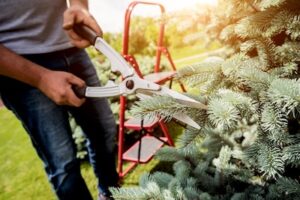Importance of Trimming for Tree Health and Growth
Tree trimming, a closely related practice to pruning, is crucial in maintaining trees’ health, aesthetics, and overall vitality. Trimming can profoundly impact a tree’s well-being when performed with a deep understanding of tree biology and specific needs. We will delve into the significance of tree trimming for tree health and growth, investigating the diverse aspects that make it a paramount component of arboriculture.

Significance of Tree Trimming
Tree trimming is more than just a cosmetic procedure for your backyard. It plays a vital role in maintaining the overall health and growth of trees. Here are some key aspects of its importance:
1. Structural Integrity and Safety
One of the primary reasons for tree trimming is to ensure trees’ structural integrity and safety. As trees grow, they may develop branches that become weak, unstable, or prone to breakage. These branches pose a significant safety hazard, especially during storms or adverse weather conditions. Trimming removes these hazardous limbs, reducing the risk of property damage and personal injury. Proper trimming helps trees maintain a stable and secure structure, stemming the possibility of branch failure.
2. Disease Prevention and Management
Tree trimming plays a pivotal role in disease prevention and management. Removing dead or diseased branches eliminates potential entry points for pathogens and pests. Additionally, trimming allows for increased air circulation and sunlight penetration within the canopy, creating an environment less conducive to developing and spreading fungal diseases. By reducing the density of the canopy, trimming helps keep trees healthy and resilient against a range of potential threats.
3. Enhanced Aesthetic Appeal
Trimming significantly enhances the aesthetic appeal of trees, making them more visually pleasing and well-proportioned. Properly trimmed trees exhibit a balanced and harmonious shape, contributing to the overall beauty of landscapes and urban environments. Aesthetically pleasing trees can increase property values, create inviting outdoor spaces, and improve the quality of life for residents.
4. Encouraging New Growth
Tree trimming is a valuable tool for stimulating new growth and rejuvenation in trees. When carefully executed, trimming can promote the development of new shoots, leaves, and branches. This is particularly beneficial for older trees that may have become overgrown, sparse, or unhealthy. By selectively removing specific branches or growth, arborists can boost the tree to redirect its energy into assembling new and vigorous growth.
5. Improved Light and Airflow
Trimming helps optimize the availability of light and airflow within a tree’s canopy. Adequate light is essential for photosynthesis, the process by which trees convert sunlight into energy. Improved airflow reduces humidity and moisture, creating an environment less conducive to fungal diseases. By thinning out branches and removing excess growth, trimming allows for better light penetration and air circulation, supporting the overall health and vitality of the tree.
6. Shaping and Size Control
Tree trimming enables arborists and tree owners to shape and control the size of trees. In urban and suburban settings, where space is limited, it is essential to shape trees to fit their surroundings. Trimming can maintain desired tree sizes, prevent overhanging branches, and create clearance around buildings, utility lines, and roads. Properly sized and shaped trees contribute to a well-maintained and safe environment.
7. Encouraging Fruit Production
Fruit-bearing trees benefit greatly from trimming, as it can usher increased fruit production and improved fruit quality. Trimming helps thin out excess branches and stimulate the growth of fruit-bearing shoots. Proper trimming techniques for fruit trees include removing dead or diseased wood, opening up the canopy for better light exposure, and maintaining a balanced structure to support the weight of fruit.
8. Young Tree Development
Trimming is especially crucial for young tree development. Properly shaping and training young trees during their formative years can have a lasting impact on their structure and health as they mature. Young tree trimming involves removing competing or crossing branches, establishing a central leader (a dominant main stem), and creating a sturdy framework for future growth. These early interventions set the stage for healthy and well-structured adult trees.
9. Encouraging Resilience
Well-trimmed trees are more resilient in the face of environmental stressors. By lessening the load on branches and eliminating weak or dead wood, trimming helps trees defy heavy winds, snow loads, and extreme weather events. Trees that are regularly trimmed are better equipped to recover from adverse conditions and continue thriving.
10. Longevity and Sustainability
Ultimately, trimming contributes to the longevity and sustainability of trees. Well-maintained trees are less susceptible to disease, structural failure, and environmental stress, allowing them to live longer and continue benefiting the environment and the community. Healthy trees offer various ecological services, from oxygen production to carbon sequestration, making them invaluable assets in the urban landscape.
When to Trim a Tree
Timing is crucial when it comes to tree trimming. Different types of trees require different schedules, but generally, late winter or early spring is ideal. This is when trees are dormant, minimizing stress and the risk of disease transmission.
How to Trim a Tree
Proper technique is essential to ensure the tree’s health. Here’s a step-by-step guide on how to trim your trees:
- Assess the Tree: Identify which branches need trimming. Look for dead, diseased, or crossing branches.
- Gather the Right Tools: Invest in high-quality pruning shears, loppers, and a pruning saw.
- Make Clean Cuts: Always make clean cuts close to the branch collar (the swollen area at the base of the branch).
- Prune Conservatively: Avoid excessive pruning, as it can stress the tree.
- Consult an Expert: For larger or hard-to-reach branches, consider consulting a professional arborist.

Frequently Asked Questions (FAQs)
Q: How often should I trim my trees?
A: The frequency of trimming depends on the type of tree, but once every 2-3 years is a general guideline.
Q: Can I trim my trees during any season?
A: It’s best to trim during late winter or early spring, but dead or hazardous branches should be removed immediately, regardless of the season.
Q: Is it possible to over-prune a tree?
A: Yes, excessive pruning can stress a tree. It’s essential to strike a balance and avoid removing more than 25% of the canopy.
Q: Do I need a permit to trim my trees?
A: Check with your local authorities, as some areas require permits for significant tree trimming.
Q: What should I do with the trimmed branches?
A: You can use them as mulch, firewood, or hire a tree removal service to dispose of them properly.
Q: Can I trim my trees myself, or should I hire a professional?
A: Small trimming tasks can be done by homeowners, but for larger trees or complex pruning, it’s advisable to hire a certified arborist.
Conclusion
Tree trimming is a fundamental practice in arboriculture that serves both the immediate needs of trees and the long-term interests of communities and ecosystems. The importance of tree trimming for tree health and growth cannot be overstated. When conducted with the care and expertise of a tree trimming company, trimming enhances safety, prevents disease, improves aesthetics, stimulates new growth, and contributes to the overall well-being of trees. Nurturing trees through trimming is an investment in a greener, healthier, and more sustainable future for future generations, as well as a nicer-looking outdoor home space.
